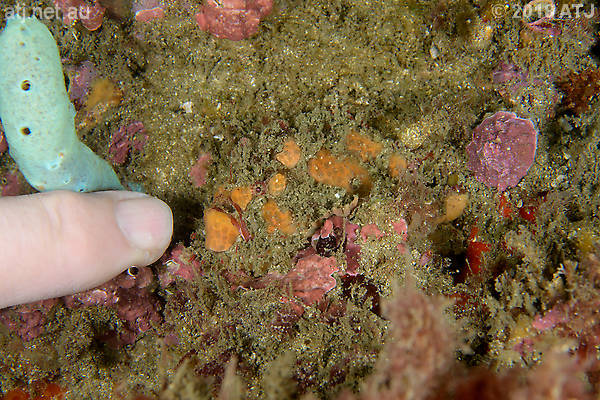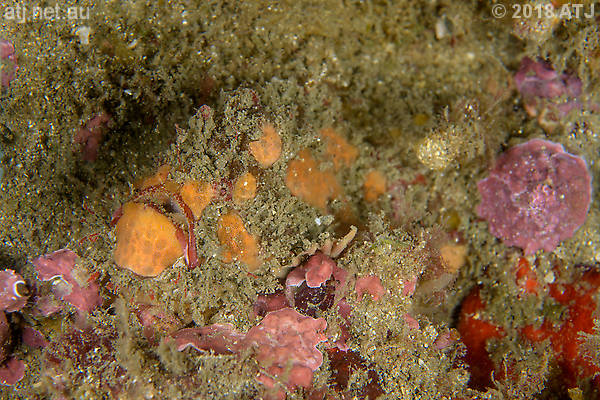Dive Details
Location
Date
Sunday 20 May 2018
Time
11:41am - 1:08pm
Details
Conditions had been alright for my first dive and so I went for a second dive at The Monument. I wanted to see if some of the animals were still around after the rough seas of the past week. I also needed to work on my dive tally as I'd barely dived with Vicki being sick and the rough seas.
I got in at the protected area around a third of the way to The Steps and waded out to the edge of the reef. I descended and swam to the sand line. The visibility here seemed better than it was at The Steps and was probably around 10 metres. The water temperature was around 18°C. There wasn't much surge but there was some current. I turned left and headed towards Sutherland Point.
I swam along the sand line and accidentally swam right past Block Rock. It was only when I got to the rock where "Honey" used to be that I realised I'd missed it. I swam back to Block Rock and looked around for seahorses and anglerfishes.
I continued to the deep wall and swam along the wall looking for anglerfishes. When I got to the spot where the ornate ghostpipefish had been last year, my eyes caught the mouth of a small red-fingered anglerfish. I'm not sure how I spotted it but there it was.
Farther along the wall I dropped down to the sand to look for the juvenile weedy seadragon. I looked in the kelp and was about to give up when I finally spotted it. It has grown so much from when I first saw it.
I continued along the wall until it ended and then swam on to Carijoa Rock. The Carijoa is starting to grow back. I looked for pygmy pipehorses but found none.
I headed up to Slope Rock and surrounding rocks and looked for more pygmy pipehorses. I also looked for Mike's orange red-fingered anglerfish but it was gone from the rock where it had been last week. The robust ghostpipefish was also gone. I couldn't find the grey red-fingered anglerfish, either.
I swam on to where the female White's seahorse had been but it appears to have moved on, as well. I assume they were affected by the rough seas.
I headed up to Seahorse Rock and found two of the Nembrotha sp. nudibranchs. I looked for the third one but couldn't see it.
I dropped back down to the reef and continued on towards Sutherland Point. I was checking out rocks for anglerfishes and pygmy pipehorses as I went.
I swam past Split Rock and on to the area where we saw the second grey red-fingered anglerfish last Thursday. It had gone, too. I looked around the area hoping it hadn't gone far but couldn't find it. I did find another Nembrotha sp. nudibranch.
I swam along the intermediate wall and down to the second Carijoa covered rock. I found the spindle cowrie in the Carijoa.
I continued to Sutherland Point and swam around the point and on to the large Carijoa covered rock where the large yellow red-fingered anglerfish had been. I then headed east to the next rock and the smaller orange red-fingered anglerfish was still there.
I headed west to the rock where "Sunshine", the female pot-bellied seahorse, had been. The pair of banded coral shrimp were still in the gap in the rock. I couldn't find "Sunshine" anywhere.
I continued west hoping to find "Sunshine", or any other seahorses and kept going until the rocks on the sand petered out. I then ascended the wall and headed south to the beach. I was did my safety stop as I went. I surfaced near the gutter and waded out.
Seas
Slight
Visibility
3 to 10 metres
Duration
86 minutes
Maximum depth
12.9 m
Average depth
10.0 m
Water temperature
17.3°C
Dive Profile from Citizen Hyper Aqualand

Tides at Botany Bay AEST
Note that tides at dive site may vary from above location.
Low
6:29am
0.36m
High
12:34pm
1.39m
Low
6:08pm
0.65m
Camera gear
Camera
Nikon D500
Lens
Nikon AF-S Micro Nikkor 60mm f/2.8G ED
Housing
Ikelite 6812.5
Lens port
Ikelite Flat Port 5502.41
Strobe
2 x Ikelite SubStrobe DS161
Photographs
Depth information, where present, indicates the depth of the camera when the photograph was taken and can be used to approximate the depth of the subject.

Red-fingered anglerfish, Porophryne erythrodactylus. 11.4 m.

Red-fingered anglerfish, Porophryne erythrodactylus. 11.3 m.

Red-fingered anglerfish, Porophryne erythrodactylus. 11.6 m.